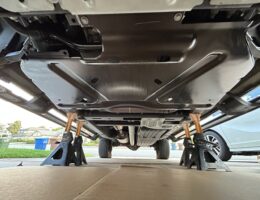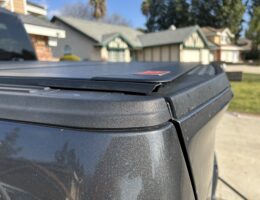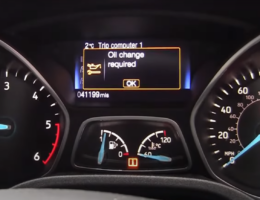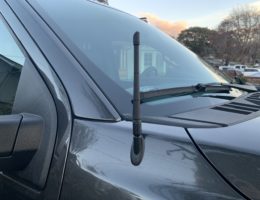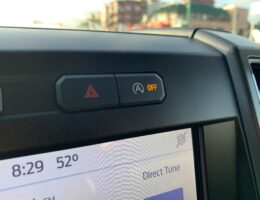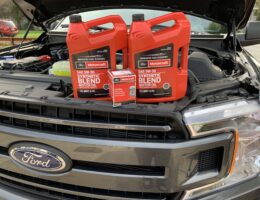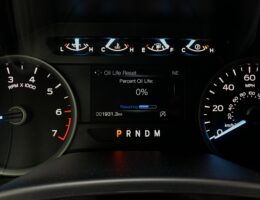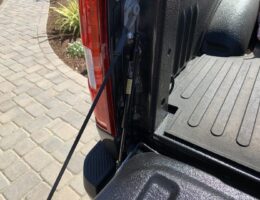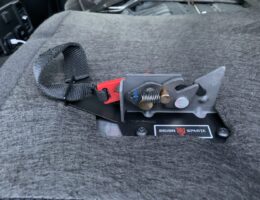On the 13th generation Ford F-150, you may have this felt under cover installed under the transmission. This part is commonly referred to as a “diaper” rather than an under cover due to it being made of a fabric-like material and commonly soaking up fluids in the undercarriage. A popular addon that will give you some protection to the undercarriage is to install a steel Raptor Skid Plate in its place.
Rough Country sells two different folding tonneau covers that costs between $650-$700, and they both seem comparable to the Bakflip MX4. I went with the one called the Tri-fold Tonneau Cover, which is similar to the Bakflip cover in that it folds out of the way for full use of the bed. I paid $700 (at time of this post) for the bed cover.
Depending on your vehicle use, your ‘Oil change required’ light may come on your instrument cluster. This can range from 3,000 miles (most severe use: max load/towing, extreme hot/cold) up to 10,000 miles (normal use: normal commuting, highway driving, little to no loading, flat terrain, no extended idling). On the Ford Focus MK3 (years 2011-2018), if you have changed your own oil (or the the shop forgot to reset your oil change reset indicator, you can easily do it by yourself.
The look of original radio antenna on my F-150 doesn’t bother me much, but I know that a ton of other F-150 owners out there have switched their antennas out for shorter ones. At first I thought it was done just for looks, but it seems that there’s a functional reason for it as well. After driving my truck through several different low-clearance parking garages, I quickly realized that the long antenna extends past the height of the roof and therefore would scrape along the beams of these parking garages. It’s incredibly annoying to have to hear it, hence the reason why I decided to replace mine.
Some folks have gotten used to the start-stop feature while others are adamantly opposed to it. For those who can’t stand auto start-stop, there are a number of ways to permanently disable the feature. These methods vary in cost, ease of installation, and have varying effects on other features of the vehicle. I’ve compiled all of the ways to permanently disable auto start-stop on the 13th gen Ford F-150 and I hope it helps you determine what is best for you if you choose to do it.
My new 2020 Ford F-150 has been babied over the past year and a half having only driven about 2,000 miles on it so far. Many folks suggest changing out the oil at 1,500 miles if its a new vehicle as you may have more deposits and metal shavings in the oil from driving a new engine. Because I tend to agree with this concept, as well as the fact that it has already been over a year, I decided to change the oil and oil filter. In this write-up I performed the oil change using Ford’s recommended Motorcraft Synthetic Blend motor oil and Motorcraft oil filter.
Depending on your trim level you may have a different size information display, or as Ford calls it a productivity screen. The XL trim has a 2.3 in. productivity screen, the XLT trim has a 4 in. productivity screen, and Lariat and better has an 8 in. productivity screen. The instructions below apply to the 13th generation Ford F-150 (model years 2015, 2016, 2017, 2018, 2019, and 2020.)
If you own a 13th generation Ford F-150 in a Lariat trim or higher, then you are blessed with the soft open of the tailgate due to it being outfitted with an OEM tailgate assist. Unfortunately if you own an XLT trim or lower trim like me, then you are met with a loud and sudden drop of the tailgate when you open it. If you prefer the soft opening of an assisted tailgate, then you have a couple of options: install a Ford OEM tailgate assist or install an aftermarket one. Since there were a high number of excellent reviews on the DeeZee tailgate assist, I decided to go this route. The install is fairly easy and doesn’t look bad.
The 13th generation Ford F-150 SuperCrew and SuperCabs have 60/40 rear seats where the entire seat bottom folds up to allow for extra storage space. In addition, the 40-side has a latch to pull the seat back down to access the jack and tire iron, however there is no latch available on the 60-side. I purchased a Seven Sparta Rear Seat Release Kit which allows you to pull down the rear seats for extra storage space behind it.

